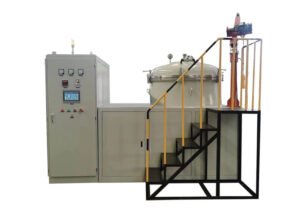Author: Xiong Yan, associate professor of Hubei University of Technology
Temperature Field Distribution of Conductive TiN and Non-conductive ZrO2 Ceramic Materials Sintered in SPS Spark Plasma Sintering Furnace
Temperature and temperature field distribution are sensitive issues in SPS Spark Plasma Sintering furnace. Many factors, such as mold and sample size, electrical conductivity, and mold powder filling, will have a greater impact on the actual temperature field distribution of the sample. Vanmessnesl et al. conducted finite element simulations on the temperature fields of SPS-sintered conductive TiN and non-conductive ZrO2 ceramic materials. The comparison results show that the non-conductive ZrO2 temperature field gradually decreases from the end near the mold’s inner wall to the sample’s interior. For the conductive TiN sample, the temperature field gradually decreases from the model’s center to the end near the inner wall of the mold. And there is a more significant radial temperature gradient in the conductive samples.
It attributed to the current passing directly through the conductive sample, thus having a more significant heat loss. Xiong et al. found it difficult to prepare large-sized and uniformly colored samples without adding sintering aids when preparing translucent AlN ceramics by SPS. It attributes to the uneven temperature field distribution of SPS sintered non-conductive ceramic samples.
The relationship between the calculated temperature and the actual measured temperature of the mold
Because it cann’t accurately measure the actual sintering temperature of the sample during the high-speed heating process, it generally measure the temperature on the surface of the mold using an optical thermometer or a thermocouple during the SPS process. Considering the wall thickness of the graphite mold for non-conductive samples, generally believed that the actual temperature acting on the sample is higher than the measured temperature. For the actual temperature of the sample in the SPS process, under the condition that the nominal sintering temperature is 1600 ºC, Suganuma et al. proposed the following approximate calculation formula:
Ts(℃)=1.154Tdie(℃)-124 (1)
Among them, Ts and Tdie are the sample’s calculated temperature and the mold’s actual measured temperature, respectively.
For non-conductive samples, the temperature and temperature field distribution of the SPS Spark Plasma Sintering furnace process are closely related to the contact resistance
For non-conductive samples, another critical factor that affects the temperature field distribution and is difficult to control is the contact resistance, which is directly related to the sample mold filling. The experimental design is shown in Fig. 3 (a), using an indenter with an outer diameter of φ20 mm and a graphite mold with an inner diameter of φ12 mm. The area with the highest temperature in the SPS sintering process is the interface between the graphite indenter and the mold because it has the most significant contact resistance and current density; different contact interfaces [(b) rough; (c) smooth] will cause Different temperature gradient distributions. Although the temperature field distribution of the graphite mold is relatively uniform, the temperature of the upper and lower surfaces of the actual sample has produced an enormous difference.
In the actual SPS Spark Plasma Sintering process, since placed the sample inside the mold cavity, the contact surface is generally the outer wall of the front end of the upper and lower indenters and the inner wall of the graphite mold. When filling the mold, it is necessary to use carbon paper to adjust the gap between the indenter and the mold. So ensuring the consistency of the upper and lower interfaces during powder filling is the key to realizing the temperature repeatability of the SPS Spark Plasma Sintering furnace process. Mazza et al. used the finite element method to model the temperature and temperature field distribution of the SPS Spark Plasma Sintering process, emphasizing that the accuracy of the simulation is closely related to the contact resistance.












